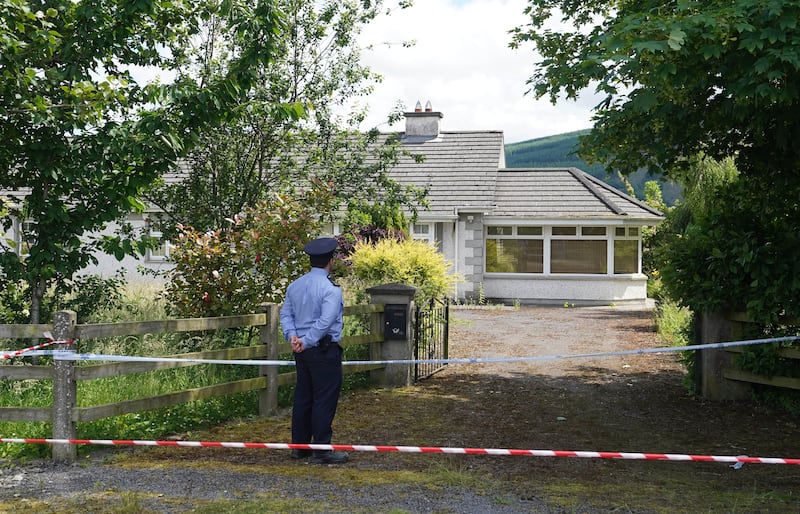The discovery of the body of a reclusive farmer in Co Kerry over Christmas – six months after he was last seen alive – highlighted yet again the phenomenon of people living and dying alone at home and not being found for weeks, months or even years later.
Michael Sheehy, a 65-year-old bachelor, lived near Duagh, a village between Listowel and Abbeyfeale, in a house on a quiet but by no means sparsely populated boreen.
“Mick was quiet, gentle, lived on his own – a bit of a recluse in his own way,” Fr Declan O’Connor, a Duagh native, told mourners at Sheehy’s funeral mass.
“[He] lived on his own, never bothered anybody and didn’t want anybody to bother him either, enjoying his own company. He loved his own music and loved his own little pad at home.”
READ MORE

The discovery of Sheehy’s body came less than a year after the extraordinary case of Kerry man Tim O’Sullivan (61). Exactly one year ago today that O’Sullivan’s remains were found in his derelict home on Beecher Street in Mallow, north Cork.
An inquest held last year into his death heard that Garda investigations involving the checking of social welfare payments and shop receipts had established he died in January 2001, suggesting that his remains lay undiscovered in the boarded-up house for about 22 years.
But while his death is perhaps the most shocking, it is by no means the only case of somebody living and dying alone.
Some of the highest-profile cases go back a generation – the discovery of sisters Mary and Ellen O’Brien in Mitchelstown in 1997.
Sociologist Dr Mark Ward of Trinity College Dublin, who has looked at isolation and loneliness among the elderly as part of the Irish Longitudinal Study on Ageing (Tilda), says their research has found that both isolation and loneliness increased during the Covid-19 pandemic.
Loneliness, he says, is the subjective feeling that the quantity and quality of a person’s relationships were less than they wanted, while isolation is more the objective measurement of how many friends a person has and how often they see them.
“What our study found is that both loneliness and isolation are really strongly associated with poor health outcomes – mental and physical health – and while loneliness is the far more important in health terms, both loneliness and isolation increased threefold during Covid,” he says.
Perhaps the most classic case of Covid impacting on an isolating couple was that of retired English couple Nicholas and Hilary Smith, who self-isolated at their home in Cloneen, Co Tipperary, about a 20-minute drive from Clonmel. They were found dead in their house in June 2022, about 18 months after they were last seen alive.

Independent councillor Mick Finn, of Cork City Council, knows of cases of elderly people living alone who died during Covid only to be found months later. He believes Covid is still having a huge impact on older people living alone.
“It’s our experience that people found it a lot more difficult to come out after Covid. People got used to staying at home. There have been cases here in Cork where people didn’t notice someone was missing because they had kept to themselves during Covid, and that Covid effect hasn’t dissipated.”
For Sean Moynihan, chief executive of Alone, the national charity that helps older people to live at home, the impact of Covid comes on top of a series of societal changes.
“There are probably three big institutional changes that have caused some of this: firstly, people are living longer, which is brilliant, so we have an ageing population; and secondly, family size has got smaller so there is less family support available and that’s also a factor,” he says.
“The third factor then is everything has moved online; people no longer collect their pension at the post office – it’s paid into their account. Maybe the local butcher or bank has closed so there are lot less places to interact with people and less opportunities for people to notice if someone is missing.”
Dr Ward points to the decline of religious practice affecting people’s mental wellbeing, since it has a spiritual effect and also provides an opportunity to meet people.
“The church, we find, is really protective against isolation,” he says.
For Moynihan and his charity, whose 4,000 volunteers interact with 35,000 older people, the problem of people dying alone and not being found is likely to escalate. He points out that research has found those over the age 80 spend 80 per cent of their time at home and are less likely to be visible to others.
It’s something society needs to fix but blaming people isn’t the way
— Sean Moynihan of Alone
“If you retire, you lose a whole circle of friends,” he says. “If you didn’t marry or you’re bereaved, you lose a friend. If your health is poor, you stop engaging with the community. If you are dependent on the pension, which is just below the poverty line, you may not have the money to be socially active.
“What we see from our stats is that the people who are lonely and are coming to us for any contact are very reliant on neighbours or family, and if their family have moved away or they are distant from their neighbours that can be a big problem and that applies to those in both rural and urban areas.”
Sean Moynihan believes the problem will become worse as people live longer and the population continues to age but he says that it’s important not to apportion blame.
“There’s a huge epidemic of loneliness out there and these cases are just the thin edge of that wedge but it’s important not to blame someone – to say: ‘Oh what’s wrong with that community that Johnny or Mary was found dead’ – it’s something society needs to fix but blaming people isn’t the way.”
Cork City Coroner Philip Comyn, who has held inquests into several such cases in the past five years, says often it can be very difficult for family or friends or neighbours to maintain contact with someone if those individuals are determined to lead private lives.
“It seems to be happening more often and the reason for that I think is that there seems to be less connectivity in society,” he says.
“But if somebody wants to be left alone – in some of the cases I dealt with, they had told family not to come near them – there’s not a lot a family can do then.”
People found dead in their homes, weeks or months after they were last seen
1997
May 3rd Sisters Mary Gertrude O’Brien (79) and Ellen (75) found dead at their home at Upper Cork Street, Mitchelstown. It’s believed they were dead almost three weeks when they were found.
2003
August 4th Agnes Lyons (70) was found in the house she shared with her siblings, Mary Ellen and Sonny. Gardaí found a sign “Agnes RIP September 13th, 2002″, suggesting she had been dead 11 months.
2009
July 23rd Body of David Barry (53) found at his home at Palmbury Orchard, Lehanaghmore, Cork. A paper boy spotted flies in the windows. His sister Valerie had last seen him alive on June 24th.
2012
March 18th English man Alan Moore (61) found at his home at John St in Wexford when a neighbour noticed Christmas lights on in the house. It’s believed he was dead around three months.
May 28th English man Philip Knight (52) was found dead at his home at Charlton Hill, New Ross, Co Wexford. He had been last seen alive around four weeks earlier.
2015
November 20th Body of Bridget Crosbie (84) found at her home at The Faythe in Wexford. A member of the Palmarian Catholic Church, a sect, she had been dead for at least two months.
2016
October 4th Bodies of brothers, Liam (76) and Daniel McCarthy (73) were found at their house at Millrose Estate, Bluebell, Dublin 12. It is thought Liam died weeks earlier and Daniel days earlier.
November 16th Body of English man Duncan Sloane (70) was found at his house at Gortnamuckla, Dunmanway, Co Cork. It is believed that he was dead for a number of weeks.
2019
April 23rd Irene Daly (82) was found at her home at Glencarra, Knock, Co Mayo. She was last seen alive on January 26th suggesting she was dead for about three months before she was found.
May 14th Body of George Harrington (79) was found in his flat at Imaal Court, The Glen in Cork. He had been last seen alive six months earlier and it was believed he died on November 18th, 2018.
July 19th Richie Scanlon (84) was found dead at his home at Madden’s Buildings in Blackpool in Cork. He was last seen alive at Christmas 2018, suggesting he was dead around six months.
2022
February 2nd Body of Michael Whiston (76) was found in his house on Lower Sallynoggin Road in Dún Laoghaire. It was believed he had died in early 2021.
April 5th Body of Breda Hayes (76) was found at her home at Hibernian Buildings, Albert Road, Cork. A widow who also lost her only son, Ms Hayes last collected her pension on January 7th, 2022.
June 20th Bodies of English couple Nicholas (82) and Hilary Smith (79) found at their home at Cloneen, Co Tipperary. Gardaí found their last activity was a text message on December 30th, 2020.
November 30th Body of English man Ray King (57) was found at his home at Woodlands, Balla, Co Mayo. Pathologist Dr Tamas Nemeth estimated that he was dead for between three to four weeks.
2023
August 17th Couple Jim and Mary McLaughlin was found dead at their home at Greenan Road, Newry, Co Down. Garden had become overgrown and they hadn’t been seen for a long time.
December 30th Michael Sheehy (65) was found dead at his well-maintained home at Scrahan, Duagh, Co Kerry. Mr Sheehy, who lived alone, was last seen alive around July 2023
- Sign up for push alerts and have the best news, analysis and comment delivered directly to your phone
- Find The Irish Times on WhatsApp and stay up to date
- Our In The News podcast is now published daily – Find the latest episode here


















